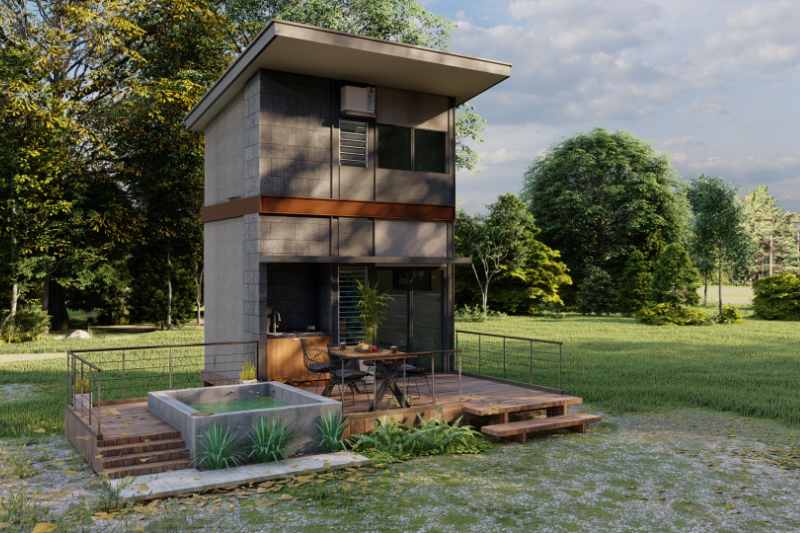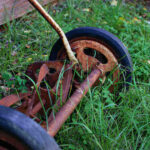Does a tiny house have a price to match its size? The national average cost of a tiny home is $46,670. Most people will pay between $30,000 and $53,335 to bring their vision to life. However, you could pay as little as $6,100 for an especially small, simple house that you partially or entirely DIY and as much as $240,000 for a luxury tiny home with many amenities.
The tiny house movement has gained popularity because of its minimalist and affordable nature compared to traditional houses. Though the low price may put homeownership within reach, consider whether you’re willing to downsize significantly to commit to this life change.
You might even want to check out our ranking of the Best States for Tiny House Living.
Average Tiny House Costs in 2024

| National Average Cost | $46,670 |
| Typical Price Range | $30,000 – $53,335 |
| Extreme Low-End Cost | $6,100 |
| Extreme High-End Cost | $240,000 |
The national average cost and typical price range reflect standard tiny homes of around 300 to 400 square feet. Houses of this size would likely have decent amenities but won’t be luxurious. Preowned tiny homes usually fall in this cost range.
To pay near the extremely low end, you’d need to DIY most, if not all, of the project using a kit or recycled materials. The home would likely be less than 200 (or even 100) square feet and only have the bare minimum amenities and utilities. You would need to use land or a trailer you already own, as both can contribute thousands of dollars to the cost.
The high-end price for tiny homes represents the largest and most luxurious of these homes, with a size of more than 600 square feet. You could buy land and deck out your home with almost all the utilities, amenities, and decorations you want. Expect tiny homes in areas with generally high housing costs to fall on this upper end, even if the same house in another area would be cheaper.
Tiny House Cost Estimator by Size
Just how tiny are we talking about? For something to be considered a tiny home, it must be significantly smaller than a traditional house.
The average size of a tiny house is 300 square feet. However, some have made do with 100 square feet or less, though you’ll need a minimalistic floor plan. Once you’re over 600 square feet, you’re inching away from the tiny home classification.
Using those square footage measurements is the easiest way to estimate the cost by size. The average cost per square foot is $280, with a typical range of $160 to $400.
Why the high price? Not all contractors are willing to work on tiny houses, so the ones that do charge more. While building costs are higher than those of a traditional house, your total construction costs will still be lower because of the small size.
Here are the costs for various tiny house sizes:
| Tiny House Size in Square Feet | Average Total Cost | Typical Total Cost Range |
| 100 | $28,000 | $16,000-$40,000 |
| 200 | $56,000 | $32,000-$80,000 |
| 300 | $84,000 | $48,000-$120,000 |
| 400 | $112,000 | $64,000-$160,000 |
| 500 | $140,000 | $80,000-$200,000 |
| 600 | $168,000 | $96,000-$240,000 |
These prices are for professional tiny house installation. You could cut costs even further by DIYing parts of the project.
Other Factors That Affect Cost
Every decision you make when building matters when you’re working in such a small space. You’ll need to consider utilities, amenities, mobility, land, materials, labor, insurance, permits, and maintenance to determine how much you need to budget. Deciding on as many of these factors as possible is crucial before starting construction and getting the cash and loans you need.
- Mobile or Stationary
- Prebuilt or Custom-Made
- Utilities
- Materials
- Labor
- Amenities
- Home Insurance
- Permits
- Maintenance and Repair
Mobile or Stationary
There are two ways to build a tiny home: with wheels or a permanent foundation.
Stationary Tiny House
Stationary tiny homes cost an average of $53,250, with the foundation costing $6,835. Permanent tiny houses provide stability, though you must purchase land to build on. If you want to build on land you already own, research local zoning laws carefully to avoid breaking any rules.
Land costs vary from city to city, between $2,500 and $81,500 per lot, with an average cost of $42,000. Need a land survey? Expect it to cost around $530. Remember that you’ll need to pay property taxes (real estate taxes) on your land and the tiny home.
Mobile Tiny House
Want more freedom? A tiny mobile home can be hitched to a trailer or drive itself. Mobile tiny houses cost an average price of $57,500. The trailer itself will cost around $7,000. A bus conversion would cost more, at around $80,000.
You will pay personal property taxes, the same taxes people pay for mobile homes, boats, and other vehicles. However, you will need to find spots to park your home, which may be frustrating.
Prebuilt or Custom-Made
You may be interested in a tiny home, but how much control do you want over its design? While most traditional homeowners purchase preowned houses, many tiny homeowners choose prefabricated or custom homes. Let’s review the pros, cons, and costs of each option.
| Type of Tiny Home | Average Cost |
| Preowned | $30,000 |
| Preowned (luxury) | $180,000 |
| Prefabricated | $86,335 |
| Shell only | $27,000 |
| Custom built | $143,335 |
| DIY kit | $7,430 |
Preowned
Some tiny home residents outgrow their homes and decide to sell. You can get preowned tiny houses for less than most new ones at an average cost of $30,000 because they tend to depreciate after they’re built. However, luxury tiny homes or those in pricey areas can still cost up to $180,000.
While you could get a good deal on a used tiny home, they’re much less plentiful than regular homes. You may struggle to find one that meets your needs, and it will be challenging to customize compared to a newly built home.
Prefabricated
While they aren’t entirely customizable, shopping for prefabricated homes will give you more flexibility than preowned tiny homes. You can browse various brands and choose a design that meets your needs and tastes. It can also lift the stress of the numerous design choices you need to make. Check whether the company offers delivery, pickup, or onsite assembly.
Prefabricated homes cost $86,335 on average. If you want more customization options, consider buying a tiny home shell for around $27,000. Please note that shells don’t include plumbing or electricity, so you must install them afterward.
Custom-Built
You may have a specific image for your tiny home that none on the market offer. In that case, talk to a contractor about a custom-built tiny house. While they can be pricey, with an average cost of $143,335, you will have control over every aspect of their design.
Kits and DIY
Some tiny home enthusiasts want to get more hands-on. A DIY tiny house kit costs around $7,430, making it one of the cheapest options. However, it’s also the most challenging option. We don’t recommend DIYing your tiny home unless you have construction experience. At the very least, you should get professional help to hook up your electrical and plumbing systems.
Utilities
Even if you are trying to simplify your life, you probably still want some of the creature comforts you’re used to. If you’re building your tiny home from scratch, you’ll need to hire a contractor to install electrical wiring and plumbing.
Electrical wiring installation costs around $1,425, and connecting to the power grid will cost around $2,625. If you want to embrace the eco-friendly nature of tiny homes, you can install solar panels for around $13,770. Plumbing installation costs around $1,180, plus an additional $10,250 if you want to connect to the sewer system.
Once all your utilities are installed, you’ll still need to pay for their usage. Tiny homeowners should expect to pay around $125 a month in utilities. This bill is much less than the utilities in most apartments because of its tiny size. To cut utility bills further, you can aim for a completely self-sufficient setup by going off-grid.
Materials
How much of your total cost will go into materials? Building materials for tiny homes cost an average of $35,415 in total. However, you can save money by using recycled or upcycled materials. For example, you can make a tiny home out of a shipping container for around $19,600 total, with the container itself costing around $3,250.
Labor
You’ll most likely need professional building help for most of the project. Paying the contractors will account for between 15% and 45% of your total project costs. While you can save by DIYing parts of the project yourself, you will likely still need to budget for some labor costs to cover anything you’re too uncomfortable or worn out to do yourself.
Amenities
What do you want in your house? Do you want the bare minimum of a bed, bathroom, and cooking apparatus, or a luxury bathtub, chandelier, marble counters, and all the kitchen gadgets you want? Though tiny houses are generally minimalist, you still have flexibility in amenities and decor.
Appliances
Appliances should be one of your top considerations when designing your tiny home. Most are outfitted with a stove, oven, fridge, toilet, shower or bathtub, and sink. Appliances usually cost $2,200, and installation will cost an additional $200. You likely won’t be able to bring all your old appliances from a bigger house, but you can discuss it with a professional builder to see what they recommend.
Some make do with smaller or more basic amenities to save money. For example, you could use a cooler instead of a fridge or a camping stove instead of a traditional cooktop.
Of course, you don’t have to sacrifice all the appliances you’re used to. You may need to downsize them compared to your old home, but you can still have a stove, oven, and bathtub if you want them. You just need to be strategic and carefully consider what you want and need. Beware of collecting too many tabletop appliances—your counter space is precious in such a small home.
Furniture
Like your old appliances, you may find that your favorite furniture doesn’t suit your new living space. Smaller furniture will not only save space but will make your tiny home feel bigger. Assess your belongings to see what can make the move with you and what needs replacing.
Other Amenities
Ask yourself: is there anything else you want to make your home feel complete? For example, you could add a home gym or garden to your tiny home. While it will be challenging to fit in extra non-essential amenities indoors, you could have plenty of space for outdoor amenities if you purchase land.
Home Insurance
Tiny homes are no less vulnerable to accidents and forces of nature than traditional homes. Protect your investment with homeowner’s insurance for around $100 a month. However, finding companies willing to insure tiny homes can be challenging.
Permits
Before you begin your project, you’ll need permits. Construction companies can help acquire these permits, but you’ll need to figure it out on your own if you’re building your own tiny home. Tiny home building permits will usually cost around $1,365.
Maintenance and Repair
Once your home is built, ensure it stays in good condition. The good news is this is much easier for a tiny home since there’s less of it to be damaged. Upkeep generally costs $775 per year. Mobile tiny homes are more susceptible to damage since they move through different climates and are more at risk of accidents on the road.
Related Services
Once you’ve committed to your new tiny home, you may need to hire other professionals to help. Here are some services you may find helpful.
Movers and Storage
Moving to a tiny home can still be a big headache. You must transport your belongings to your new house or a storage unit. Professional movers cost $1,340 on average, depending on how much you need to transport and how far you’re moving.
While you could rid yourself of all your old belongings before you move, sometimes you need more time. You could test out different furniture in your tiny home before getting rid of the extra. You may also want to keep some sentimental pieces that don’t work with your new lifestyle. Expect to pay an extra $75 for stops to a storage unit and $210 per month for storage unit rental.
Painting
When customizing your new tiny home, you may not like its current color. Dark colors can make a room look small and cramped, which isn’t ideal for already tiny spaces. Light, bright colors can make spaces look bigger, subtly enhancing your living space.
You can hire a professional exterior painter for $2.71 per square foot. If the interior needs a change of hue, hire an interior painter for around $3 per square foot.
Pro Cost vs. DIY Cost
Building your own tiny house is much more attainable and affordable than building a traditional house in many ways. However, it’s still a huge undertaking. Your costs will vary depending on if you use a kit or build from scratch. Here are some of the tools and materials you would need to purchase:
| Tools and Materials | Average Cost |
| DIY kit | $7,430 |
| Building materials (if building from scratch) | $35,810 |
| Safety goggles | $14 |
| Hearing protection | $16 |
| Work gloves | $18 |
| Dust mask | $12 |
| Toolbelt | $83 |
| Chalk line | $12 |
| Tape measure | $18 |
| Level | $35 |
| Speed square | $17 |
| Hammer | $18 |
| Buying a nail gun | $75 |
| Renting a nail gun | $29 per day |
| Nails | $12 |
| Cordless drill | $120 |
| Screwdriver | $15 |
| Screws | $0.30 each |
| Buying a circular saw | $120 |
| Renting a circular saw | $24 per day |
| Buying a table saw | $382 |
| Renting a table saw | $49 per day |
| Buying a miter saw | $400 |
| Renting a miter saw | $49 per day |
| Oscillating saw | $66 |
| Buying a reciprocating saw | $220 |
| Renting a reciprocating saw | $24 per day |
| Pliers | $26 |
| Clamp | $9 |
| Extension cord | $30 |
| Orbital sander | $68 |
| Ladder | $125 |
| Exterior paint (latex) | $20 to $63 per gallon |
| Interior paint | $30 per gallon |
| Paintbrush | $10 |
| Paint roller | $15 |
| Painter’s tape | $10 |
| Paint tray | $4 |
Because of the difficulty of this project, we don’t recommend it for first-time DIYers. Home building can be dangerous for those not experienced in construction, and a poorly made house will not serve you well in the long term. It will also take you much longer than a professional team to complete. While pros can build a tiny house in 120 hours, a DIYer could take as much as 480 hours.
However, you can still cut costs by DIYing some parts of the project, such as painting. You could save thousands of dollars by taking on as much of the project as possible.
Cost of Tiny Houses by Location
Building your dream tiny home could look much different in New York compared to Texas. The local cost of living, materials, land, and labor will all affect how much you pay. Rural areas tend to have less strict rules and regulations, potentially saving you money.
The popularity of tiny houses in your area will also sway prices. Check for tiny house communities or locally-based companies.
FAQ
What Are the Pros and Cons of Tiny Houses?
Downsizing to a tiny home is a big decision. If you need help deciding, here are the benefits and downsides of tiny houses:
Pros:
- Encourages minimalism and downsizing
- Cheaper than traditional housing
- Allows flexibility in location, especially if your tiny home is mobile
- More eco-friendly than traditional housing
Cons:
- Less space for activities and storage
- Restricted by zoning rules
- Little resale value
- Challenging to insure and fund with loans
Are Tiny Homes Legal in Every State?
Tiny homes aren’t outright illegal in any state, but you’ll need to check your county or city’s zoning laws. They may limit where you can build or if you can build at all. The laws in your area may end up being so strict that it’s not worth pursuing.
How Can I Fund My Tiny Home Project?
While it’s relatively easy to get loans and mortgages for traditional homes, tiny homes are a different story. You’ll likely need cash, a personal loan, or a land loan. Many lenders hesitate to provide land loans because of the more significant risk and difficulty determining land value. Therefore, you will need a good credit score and may need to pay a higher down payment and interest rate.
Finding Your New Home (And Local Pros)
The average tiny house cost of $46,670 is much cheaper than the average traditional home. Though this option is appealing in many ways, you’ll need to do much more research and planning to bring your idea to fruition. Look into local tiny home communities and general contractor companies to start your downsizing journey.
Note: Lawn Starter may get a referral fee for matching you with contractors in your area.
Main Image Credit: Westhoff / Canva Pro / License





